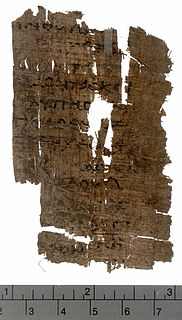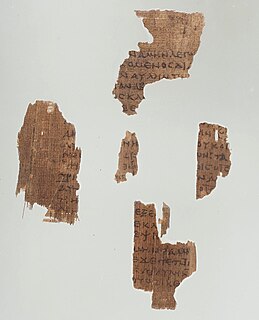
The League of Corinth, also referred to as the Hellenic League, was a confederation of Greek states created by Philip II during the winter of 338 BC/337 BC after the Battle of Chaeronea and succeeded by Alexander the Great at 336 BC, to facilitate the use of military forces in the war of a unified Greece under Macedonian leadership (hegemony) against Persia. The name 'League of Corinth' was invented by modern historians due to the first council of the League being in Corinth. It was the first time in history that most of the Greek states managed to become part of a single political entity. Earlier, in 346 BC, Isocrates urged Philip to unify Greece against the Persians.

The Codex Bezae Cantabrigensis, designated by siglum Dea or 05, δ 5, is a codex of the New Testament dating from the 5th century written in an uncial hand on vellum. It contains, in both Greek and Latin, most of the four Gospels and Acts, with a small fragment of 3 John. Written one column per page, the codex contains 406 extant parchment leaves measuring 26 x 21.5 cm, with the Greek text on the left face and the Latin text on the right. A digital facsimile of the codex is available from Cambridge University Library, which holds the manuscript.

Papyrus 1 designated by "𝔓1", "ε 01 ", is an early copy of the New Testament in Greek. It is a papyrus manuscript of the Gospel of Matthew dating palaeographically to the early 3rd century. It is currently housed at the University of Pennsylvania Museum, and was discovered in Oxyrhynchus, Egypt.

Uncial 030, designated by siglum U or 030, ε 90, is a Greek uncial manuscript of the New Testament on parchment, dated palaeographically to the 9th century. The manuscript has complex contents, with full marginalia.

Papyrus 69 is a small fragment from the Gospel of Luke dating to the 3rd century.

Papyrus 6, designated by 𝔓6 or by ε 021, is a fragmentary early copy of the New Testament in Greek and Coptic (Akhmimic). It is a papyrus manuscript of the Gospel of John that has been dated paleographically to the 4th century. The manuscript also contains text of the First Epistle of Clement, which is treated as a canonical book of the New Testament by the Coptic Church. The major part of the codex is lost.
Papyrus 19, signed by 19, is an early copy of the New Testament in Greek. The manuscript paleographically has been assigned to the 4th or 5th century.

Papyrus 49 (Gregory-Aland), designated by 49, is an early copy of the New Testament in Greek. It is a papyrus manuscript of the Epistle to the Ephesians, surviving in a fragmentary condition. The manuscript has been palaeographically assigned to the 3rd century. It was probably a part of the same manuscript as Papyrus 65. It came from Egypt and was purchased for the Yale University Library. Textually it is close to the Codex Sinaiticus and Codex Vaticanus. The text of the manuscript has been published several times.

Papyrus 63, designated by 63, is a copy of the New Testament in Greek. It is a papyrus manuscript of the Gospel of John. The surviving text of John are verses 3:14-18; 4:9-10. The manuscript paleographically had been assigned to the 4th century.

Papyrus 98, designated by 98, is an early copy of the New Testament in Greek. It is a papyrus manuscript of the Book of Revelation. The manuscript palaeographically had been assigned to years 150–250.

Papyrus 100, designated by siglum 100, is an early copy of the New Testament in Greek. It is a papyrus manuscript of the Epistle of James. The surviving texts of James are verses 3:13-4:4; 4:9-5:1, they are in a fragmentary condition. The manuscript has been assigned paleographically to the late 3rd century, or early 4th century.
Family Π is a group of New Testament manuscripts. Belonging to the Byzantine text-type, it is one of the textual families of this group. The name of the family, "Π", is drawn from the symbol used for the Codex Petropolitanus. One of the most distinct of the Byzantine sub-groups, it is very old and the third largest. The oldest Byzantine manuscripts belong to this family.
Family E is a textual group of the New Testament manuscripts. It belongs to the Byzantine text-type as one of its textual families, it is one of the primary early families of the Byzantine text-type. The name of the family came from the symbol of Codex Basilensis, the lead manuscript of the family, which is designated by symbol E.
The Epistula ad Carpianum or Letter of Eusebius is the title traditionally given to a letter from Eusebius of Caesarea to a Christian named Carpianus.
Textual variants in the New Testament manuscripts arise when a copyist makes deliberate or inadvertent alterations to the text that is being reproduced. Textual criticism of the New Testament has included study of its textual variants.
Family Kr is a large group of the New Testament manuscripts. It belongs to the Byzantine text-type as one of the textual families of this group. The group contains no uncial manuscripts, but is represented by a substantial number of minuscules.
Codex Sinaiticus and Codex Vaticanus, two of great uncial codices, representatives of the Alexandrian text-type, are considered excellent manuscript witnesses of the text of the New Testament. Most critical editions of the Greek New Testament give precedence to these two chief uncial manuscripts, and the majority of translations are based on their text. Nevertheless, there are many differences between these two manuscripts. According to Dean Burgon: "It is in fact easier to find two consecutive verses in which these two MSS differ the one from the other, than two consecutive verses in which they entirely agree."
Minuscule 686, Θε34, is a Greek minuscule manuscript of the New Testament, on parchment. It is dated by a colophon to the year 1337. Some leaves of the manuscript were lost. Scrivener labelled it by 573e.

Textual variants in the Gospel of Matthew are the subject of the study called textual criticism of the New Testament. Textual variants in manuscripts arise when a copyist makes deliberate or inadvertent alterations to a text that is being reproduced. An abbreviated list of textual variants in this particular book is given in this article below.

Textual variants in the Gospel of Luke are the subject of the study called textual criticism of the New Testament. Textual variants in manuscripts arise when a copyist makes deliberate or inadvertent alterations to a text that is being reproduced. An abbreviated list of textual variants in this particular book is given in this article below.











